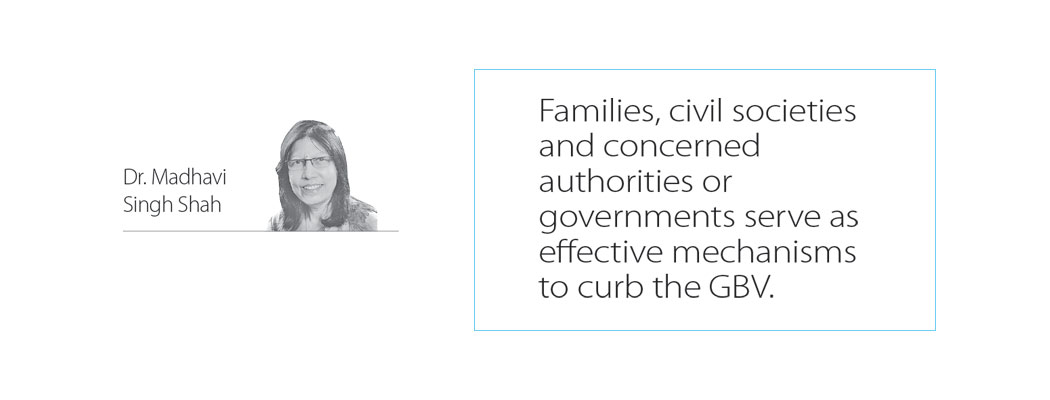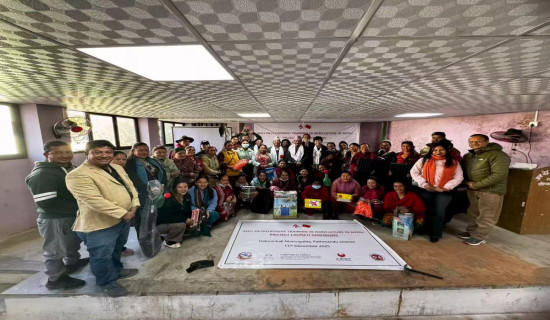- Saturday, 13 December 2025
GBV Hinders Economic Development
It has been proven fact that, inequalities or discrimination against gender has adverse effects in all societies and nations. Not only does it slow down economic growth but it also puts heavy costs on social, cultural and religious sectors as well. Gender Based Violence (GBV) also creates turmoil in families, communities, civil societies, across the world. This, type of violence cannot be characterized only, as gender based violence. It is a severe assault of human rights too, which the world has long stood against and condemned.
It is not the case of Nepal or South Asia only, but is spread across the world even among affluent or developed countries and societies. Sexual and gender based violence (SGBV) may be misunderstood like a private affair requiring discussion only within the family. However, its perception as a family affair has led to a serious under-reporting of violence against women. As per various news sources (Sept 30, 2022) globally, almost 736 million or about 30 per cent of women experience intimate partner or non-partner sexual violence. Despite the under reporting we are coming up with this huge number, it certainly is clear that gender based violence (GBV) is one of the most prevalent and severe forms of violation of human rights.
Lower economic activities
The experiences of developed and developing countries reveal that higher levels of violence against women result in lower economic activities driven mainly by a remarkable drop in female employment. Women bear huge care-giving roles and responsibilities to family and households throughout the life cycle. This extensive swaths of the workforce lack paid leave and other important protection that support labour force engagement, leading many women to either reduce their work hours or drop out of the labour force entirely. Moreover, the physical, emotional and psychological torture that women face creates difficulties for them to deliver their set job assignments too. In fact, SGBV tends to decrease active participation of women in development.
Global records show since the1980’s, women’s participation in economy, has grown significantly. In USA, Canada and Scandinavian countries, women represent almost half of the active population, contributing extensively in multi-dimensional areas. The major reasons behind, may be backed by strong law and order mechanism, although these countries are also not violation free. But observations clearly indicate, the lesser the gender discrimination or violation, the bigger women’s participation in development sectors. Compared to European and American societies, in Arab (Middle East), Asian countries and societies, women’s direct participation in labour market remain lower, not only due to the economic aspects, but could be attributed to social-cultural legal structures and norms.
Obviously, countries recording low profile of women with mental and physical violations or rights abuses refrain them from nation building process in larger prospective. As a result, a valuable asset of population (productive, human resource) in the form of women is not supported the same way as men for the development process. The gender-based desecration against women, obviously lower-down economic activities. This socially accepted bias against; this particular precious human resource will-obviously result adverse in economic activities and achievements.
In Nepal, SGBV is the outcome of societal scenario that has led gender inequalities and discrimination faced by women. It prevails mostly in socio-cultural, economic practices and religious grounds. Moreover the traditional roles between men and women also emerge as influencing factor behind the patriarchal norms. Women have lesser access to home and refrained from decision making on significant issues. Records indicate women’s inequalities in Nepal stressing that one-third of women have no education, fifty-two percent of women are involved in non-paid jobs, and women are less likely than men to run the family business or actual ownership of property.
Actually, GBV can manifest in various forms like domestic violence, trafficking, sexual assault to dowry-related brutality, child marriages and female infanticide, etc. In Nepal, however, the shadows of various forms of GBV lurked to the forefront during the first COVID-19 global lockdowns as when families were forced to spend longer hours together. According to United Nations Populations Fund, almost 48 per cent of Nepali women say that they have experienced some form of violence at some point in their lives, with 15 per cent experiencing sexual violence. Demographic Health Survey 2016 reveals, between the ages of fifteen to twenty-two, seven per cent of women experience physical and sexual violence. Based on police records and various sources, 21,568 cases were reported during 2021/2022. In Nepal GBV affects more than one in four women and girls.
While assessing women’s participation in economy, the average value for Nepal during 2020 was 80.83 per cent with a minimum of 75.7 per cent and a maximum of 82.49 per cent in 2019. The latest value from 2021 is 78.69 per cent. For comparison, the world average in 2021 based on 180 countries is 50.13 per cent. Obviously some immediate steps need to be taken by concerned sectors to curb this anti-social practice and for accelerating the participation of women in the economy. Families, civil societies and concerned authorities or governments serve as effective mechanisms to curb the GBV.
Holistic approach
Considering the practices and perceptions identified, as well as the barriers that prevent achieving the full intent of the Anti-GBV Act, it is necessary to have a broad, holistic approach to push forward for actions with the large-scale public awareness and sensitisation of the full scope of the Act and its effective implementation. As countries develop with education and economic prosperity reach out to the corners of the world, populations all over the world are bound to realise and address the issue with effective action for tangible change. At the same time, a more effective coordination of stakeholders to deliver comprehensive, integrated, survivor-centered services, must be initiated to alleviate affected women’s state and encourage them to involve in development areas.
It can come forward as pressure group to influence the government and other connected agencies for implementation of necessary measures to form a better society free from any type of gender based violence. Strengthening and coordination of all concerned agencies with their commitment and actions could definitely meet the desired goal to set gender-violence free society encouraging active participation of women (a very valuable asset) in development that influence and sanction the national economic growth.
(Dr. Shah is Professor & former HOD of Central Department of Economics, Tribhuvan University. )

















